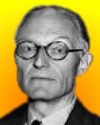
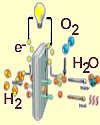
English mechanical engineerwho pioneered the first modern hydrogen-oxygen fuel cells, which electrochemically convert air and fuel directly into electricity. The principle was first observed by Sir William Grove (1842) when he supplied oxygen and hydrogen to platinum electrodes immersed in sulphuric acid and a current was produced in an external circuit. It remained a curiosity until Bacon began serious research in the early 1940s for proposed application in submarines. By 1959 he developed a successful six-kilowatt fuel cell. When fuel cells were used by U.S. Apollo space vehicles, they could both provide in-flight power and clean drinking water, the by-product of the electrochemical reaction.«[Image: fuel cell schematic (source)]
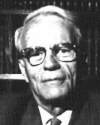
1984
Born 21 Dec 1898; died 6 Feb 1973 at age 74.
Ira Sprague Bowen was an American astrophysicist whose investigation of the ultraviolet spectra of highly ionized atoms led to his explanation of the unidentified strong green spectral lines of gaseous nebulae (clouds of rarefied gas) as forbidden lines of ionized oxygen and nitrogen. This emission, appearing to match no known element, had formerly been suggested to be due to a hypothetical element, “nebulium.” Bowen was able to show, that in reality, the emission lines exactly matched those calculated to be the “forbidden lines” of ionized oxygen and nitrogen under extremely low pressure. This made a major advance in the knowledge of celestial composition. He was director of the Mt. Wilson and Palomar Observatories from 1948-64.«
Ira Sprague Bowen was an American astrophysicist whose investigation of the ultraviolet spectra of highly ionized atoms led to his explanation of the unidentified strong green spectral lines of gaseous nebulae (clouds of rarefied gas) as forbidden lines of ionized oxygen and nitrogen. This emission, appearing to match no known element, had formerly been suggested to be due to a hypothetical element, “nebulium.” Bowen was able to show, that in reality, the emission lines exactly matched those calculated to be the “forbidden lines” of ionized oxygen and nitrogen under extremely low pressure. This made a major advance in the knowledge of celestial composition. He was director of the Mt. Wilson and Palomar Observatories from 1948-64.«
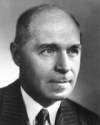
Born 21 Dec 1890; died 5 Apr 1967 at age 76. quotes
American geneticist who demonstrated that mutations and hereditary changes could be caused by X-rays striking the genes and chromosomes of living cells (first produced in the fruit fly Drosophila in 1927). His first task - to create procedures to exactly measure the mutation frequency - took several years. Then he investigated the effect of different agents on the frequency of mutations. He found that experiments could be arranged, for instance, so that nearly 100 per cent of the offspring of irradiated flies showed mutations. Thus a possibility had been created for the first time of influencing the hereditary mass itself artificially. Muller was awarded the Nobel Prize for Physiology or Medicine in 1946.«
American geneticist who demonstrated that mutations and hereditary changes could be caused by X-rays striking the genes and chromosomes of living cells (first produced in the fruit fly Drosophila in 1927). His first task - to create procedures to exactly measure the mutation frequency - took several years. Then he investigated the effect of different agents on the frequency of mutations. He found that experiments could be arranged, for instance, so that nearly 100 per cent of the offspring of irradiated flies showed mutations. Thus a possibility had been created for the first time of influencing the hereditary mass itself artificially. Muller was awarded the Nobel Prize for Physiology or Medicine in 1946.«
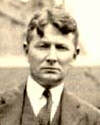
1928
Born 21 Dec 1889; died 3 Mar 1988 at age 98. quotes
American population geneticist and evolutionary theorist who was one of the founders of modern theoretical population genetics. He researched the effects of inbreeding and crossbreeding with guinea pigs, and later on the effects of gene action on inherited characteristics. He adopted statistical techniques to develop evolutionary theory. Wright is best known for his concept of genetic drift, called the Sewall Wright effect - that when small populations of a species are isolated, out of pure chance the few individuals who carry certain relatively rare genes may fail to transmit them. The genes may therefore disappear and their loss may lead to the emergence of new species, although natural selection has played no part in the process.«
American population geneticist and evolutionary theorist who was one of the founders of modern theoretical population genetics. He researched the effects of inbreeding and crossbreeding with guinea pigs, and later on the effects of gene action on inherited characteristics. He adopted statistical techniques to develop evolutionary theory. Wright is best known for his concept of genetic drift, called the Sewall Wright effect - that when small populations of a species are isolated, out of pure chance the few individuals who carry certain relatively rare genes may fail to transmit them. The genes may therefore disappear and their loss may lead to the emergence of new species, although natural selection has played no part in the process.«
Sewall Wright and Evolutionary Biology, by William B. Provine. - book suggestion.
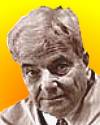
Born 21 Dec 1883; died 8 May 1968 at age 84. quotes
American herpetologist, engineer and inventor whose interest was rattlesnakes, studying their natural history and relationship to humans. He advanced methods of taxonomy, was a tireless innovator, and amassed a personal collection of 36,000 preserved specimens. His studies had an emphasis on venom collection and antivenin. Further, being familiar with statistical treatment of data because of his engineering background, he was the first to apply statistical methods to herpetological taxonomy and to think of species in terms of populations in nature rather than as species in museum jars. His unique compendium, Rattlesnakes: Their Habits, Life Histories and Influence on Mankind, remains the authoritative source for information.«
American herpetologist, engineer and inventor whose interest was rattlesnakes, studying their natural history and relationship to humans. He advanced methods of taxonomy, was a tireless innovator, and amassed a personal collection of 36,000 preserved specimens. His studies had an emphasis on venom collection and antivenin. Further, being familiar with statistical treatment of data because of his engineering background, he was the first to apply statistical methods to herpetological taxonomy and to think of species in terms of populations in nature rather than as species in museum jars. His unique compendium, Rattlesnakes: Their Habits, Life Histories and Influence on Mankind, remains the authoritative source for information.«
Rattlesnakes, by Laurence Monroe Klauber. - book suggestion.
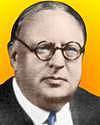
Born 21 Dec 1868; died 15 Jun 1934 at age 65.
George Warren Fuller was an American engineer who was an industry pioneer in the purification of water for drinking, and the treatment of sewage. While training at M.I.T., (influenced by such people as Ellen H. Swallow Richards, William T. Sedgwich and Hiram F. Mills) he became interested in the new science of public health. His five years working for the Massachusetts board of health, including some time in charge of the Lawrence Experiment Station, recognized as a leading center of research in civil water supplies. In 1895, he spent time at the Experiment Station, Louisville Kentucky, studying rapid filration. While there, he conducted the first tests in America of water disinfection using chlorine gas to purify the Ohio River water supply. Shortly after, he began decades as a consulting sanitary engineer, skilled in pursuation, who advised more than 150 cities, commissions and corporations throughout America, and also in Canada and China.«
George Warren Fuller was an American engineer who was an industry pioneer in the purification of water for drinking, and the treatment of sewage. While training at M.I.T., (influenced by such people as Ellen H. Swallow Richards, William T. Sedgwich and Hiram F. Mills) he became interested in the new science of public health. His five years working for the Massachusetts board of health, including some time in charge of the Lawrence Experiment Station, recognized as a leading center of research in civil water supplies. In 1895, he spent time at the Experiment Station, Louisville Kentucky, studying rapid filration. While there, he conducted the first tests in America of water disinfection using chlorine gas to purify the Ohio River water supply. Shortly after, he began decades as a consulting sanitary engineer, skilled in pursuation, who advised more than 150 cities, commissions and corporations throughout America, and also in Canada and China.«
Sewage Disposal, by George Warren Fuller. - book suggestion.
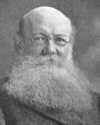
Born 21 Dec 1842; died 8 Feb 1921 at age 78. quotes
Russian geographer and revolutionist, who combined biological and historical fact to arrive at his theory of Mutual Aid (1902). While an army officer in Siberia (1862-67), he studied the native animals, made geographical surveys, and examined the effects of the Ice Age in Asia and Europe. His investigation of the structural lines of mountain ranges revised the cartography of eastern Asia. He wrote a series of articles against social Darwinism and its tenet of the benefits of competition. Kropotkin asserted that sociability characterized animals. Thus, he held, cooperation rather than struggle guided the evolution of man and human intelligence. His greatest renown, though, was as an anarchist.«
Russian geographer and revolutionist, who combined biological and historical fact to arrive at his theory of Mutual Aid (1902). While an army officer in Siberia (1862-67), he studied the native animals, made geographical surveys, and examined the effects of the Ice Age in Asia and Europe. His investigation of the structural lines of mountain ranges revised the cartography of eastern Asia. He wrote a series of articles against social Darwinism and its tenet of the benefits of competition. Kropotkin asserted that sociability characterized animals. Thus, he held, cooperation rather than struggle guided the evolution of man and human intelligence. His greatest renown, though, was as an anarchist.«
Mutual Aid: A Factor of Evolution, by Peter Kropotkin. - book suggestion.
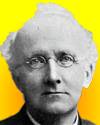
Born 21 Dec 1821; died 31 Oct 1897 at age 75. quotes
Irish physicist and geologist who was a Victorian polymath with interests in fields as diverse as mathematics, geology, the age of the earth, animal mechanics, hydrostatics, chemistry. In his later life, he turned to medical education. Several texts he wrote (or co-wrote with Joseph Galbraith) explored these subject. He was opposed to Darwin’s theory of evolution, which may have clouded his eminence in the years after his death.
Irish physicist and geologist who was a Victorian polymath with interests in fields as diverse as mathematics, geology, the age of the earth, animal mechanics, hydrostatics, chemistry. In his later life, he turned to medical education. Several texts he wrote (or co-wrote with Joseph Galbraith) explored these subject. He was opposed to Darwin’s theory of evolution, which may have clouded his eminence in the years after his death.
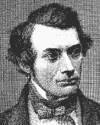
Born 21 Dec 1805; died 16 Sep 1869 at age 63. quotes
Scottish physical chemist who is often referred to as “the father of colloid chemistry.” He studied the diffusion of gases and in 1833 proposed Graham's Law, which stated that the rate of diffusion of a gas is inversely proportional to the square root of its molecular weight. Later, he extended this work to the diffusion of one liquid into another. He classified solutes into crystalloids (such as salt or sugar), and colloids (such as gum arabic and the finely divided gold suspensions of his colleague, Michael Faraday), which marked the beginning of colloid chemistry. He developed dialysis to separate colloidal solutions from electrolytes. This dialysis technique is now important in medicine. He also invented a compensated pendulum using a bob with a mercury reservoir.«[DSB gives dates 21 Dec 1805 - 16 Sep 1869. EB gives 20 Dec 1805 - 11 Sep 1869.]
Scottish physical chemist who is often referred to as “the father of colloid chemistry.” He studied the diffusion of gases and in 1833 proposed Graham's Law, which stated that the rate of diffusion of a gas is inversely proportional to the square root of its molecular weight. Later, he extended this work to the diffusion of one liquid into another. He classified solutes into crystalloids (such as salt or sugar), and colloids (such as gum arabic and the finely divided gold suspensions of his colleague, Michael Faraday), which marked the beginning of colloid chemistry. He developed dialysis to separate colloidal solutions from electrolytes. This dialysis technique is now important in medicine. He also invented a compensated pendulum using a bob with a mercury reservoir.«[DSB gives dates 21 Dec 1805 - 16 Sep 1869. EB gives 20 Dec 1805 - 11 Sep 1869.]
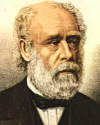
Born 21 Dec 1803; died 22 Jan 1887 at age 83.
English mechanical engineer (Baronet), who pioneered precision measurement. He held many patents for machine tools, textile and knitting machinery, and road-sweeping machines. He originated a scraping technique to make a true plane surface (1825). He advocated using the decimal system. In 1841, his standard screw threads were adopted by the Woolwich Arsenal. By 1851 Whitworth's machine tools were internationally known for their accuracy and quality, as well as his screw cutting lathes, his planing, drilling, slotting, and shaping machines, and his millionth-part measuring machine. He also did pioneering work in ordnance, creating a method for casting ductile steel to replace hard steel, which is subject to fracture.«
English mechanical engineer (Baronet), who pioneered precision measurement. He held many patents for machine tools, textile and knitting machinery, and road-sweeping machines. He originated a scraping technique to make a true plane surface (1825). He advocated using the decimal system. In 1841, his standard screw threads were adopted by the Woolwich Arsenal. By 1851 Whitworth's machine tools were internationally known for their accuracy and quality, as well as his screw cutting lathes, his planing, drilling, slotting, and shaping machines, and his millionth-part measuring machine. He also did pioneering work in ordnance, creating a method for casting ductile steel to replace hard steel, which is subject to fracture.«
Sir Joseph Whitworth: The World's Best Mechanician, by Norman Atkinson. - book suggestion.
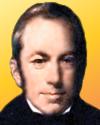
Born 21 Dec 1773; died 10 Jun 1858 at age 84. quotes
Scottish botanist who was an outsatanding authority on plant physiology in his day. He improved the natural classification of plants by establishing and defining new families and genera, but is best known for being the first to notice the natural continuous movement of minute particles in colloidal solution (1828), since known as Brownian movement. Later scientists recognized that this gives direct evidence of molecular motion in liquids, and links to the kinetic theory of gases. Brown distinquished (1826) between what became known as the conifers (gymnosperms) and the flowering plants (angiosperms). In living cells he recognized a structure for which he coined the name nucleus (Latin: "little nut").«
Scottish botanist who was an outsatanding authority on plant physiology in his day. He improved the natural classification of plants by establishing and defining new families and genera, but is best known for being the first to notice the natural continuous movement of minute particles in colloidal solution (1828), since known as Brownian movement. Later scientists recognized that this gives direct evidence of molecular motion in liquids, and links to the kinetic theory of gases. Brown distinquished (1826) between what became known as the conifers (gymnosperms) and the flowering plants (angiosperms). In living cells he recognized a structure for which he coined the name nucleus (Latin: "little nut").«
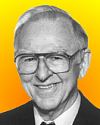
Died 21 Dec 2009 at age 91 (born 6 Jun 1918).
Edwin Gerhard Krebs was an American biochemist who shared (with Edmond H. Fischer) the 1992 Nobel Prize for Physiology or Medicine. They discovered reversible protein phosphorylation, a biochemical process that regulates the activities of proteins in cells and thus governs countless processes that are necessary for life. Malfunctions in protein phosphorylation have been implicated in the causation of diseases such as diabetes, cancer, and Alzheimer's disease.«
Edwin Gerhard Krebs was an American biochemist who shared (with Edmond H. Fischer) the 1992 Nobel Prize for Physiology or Medicine. They discovered reversible protein phosphorylation, a biochemical process that regulates the activities of proteins in cells and thus governs countless processes that are necessary for life. Malfunctions in protein phosphorylation have been implicated in the causation of diseases such as diabetes, cancer, and Alzheimer's disease.«
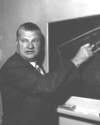
Died 21 Dec 1990 at age 80 (born 27 Feb 1910).
Clarence Leonard "Kelly" Johnson was an American aeronautical engineer who introduced introduced innovative designs. While managing Lockheed's secret project division, known as the “Skunk Works,” he contributed to more than 40 airplanes. His early work included the P-38 Lightning fighter (1938) and the Hudson bomber. Later, he developed the fastest supersonic and highest-flying airplanes in the world. The U-2 (1954) was the first plane designed for routine flight above 60,000 feet. The F-104 Starfighter interceptor (1954) was capable of flying at twice the speed of sound, setting world records of 1,400 mph and 103,000 ft altitude.«
Clarence Leonard "Kelly" Johnson was an American aeronautical engineer who introduced introduced innovative designs. While managing Lockheed's secret project division, known as the “Skunk Works,” he contributed to more than 40 airplanes. His early work included the P-38 Lightning fighter (1938) and the Hudson bomber. Later, he developed the fastest supersonic and highest-flying airplanes in the world. The U-2 (1954) was the first plane designed for routine flight above 60,000 feet. The F-104 Starfighter interceptor (1954) was capable of flying at twice the speed of sound, setting world records of 1,400 mph and 103,000 ft altitude.«
Kelly: More Than My Share of It All, by Clarence L. "Kelly" Johnson. - book suggestion.
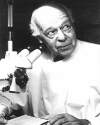
Died 21 Dec 1988 at age 94 (born 20 Feb 1894).
American psychobiologist who discovered the body's biorhythms and identified the part of the brain that controls daily cycles of sleeping, waking and other activities. He first wrote about this biological clock in a 1927 paper in which he described how internal cycles control an animal's drinking, eating, running, and sexual behaviour. He also studied the great extent to which animal biological processes can be modifed by learned behaviour. Richter connected the discovery of fire by ancient peoples to significant modifications in habits, communication, learning and even resulted in changes in brain structure. He related behaviour and the biochemistry of sleep, stress, and the onset of disease. Altogether Richter wrote over 250 research papers.«
American psychobiologist who discovered the body's biorhythms and identified the part of the brain that controls daily cycles of sleeping, waking and other activities. He first wrote about this biological clock in a 1927 paper in which he described how internal cycles control an animal's drinking, eating, running, and sexual behaviour. He also studied the great extent to which animal biological processes can be modifed by learned behaviour. Richter connected the discovery of fire by ancient peoples to significant modifications in habits, communication, learning and even resulted in changes in brain structure. He related behaviour and the biochemistry of sleep, stress, and the onset of disease. Altogether Richter wrote over 250 research papers.«
Biological clocks in medicine and psychiatry, by Curt Paul Richter. - book suggestion.
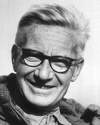
Died 21 Dec 1988 at age 81 (born 15 Apr 1907). quotes
Dutch-born English ethologist, a zoologist who studied the behaviour of animals in their natural habitats, who shared (with Konrad Lorenz and Karl von Frisch) the Nobel Prize for Physiology or Medicine in 1973 for "for their discoveries concerning "organization and elicitation of individual and social behaviour patterns." He is known for his long-term field observations of the social patterns, courtship and mating behaviour of seagulls, made in their natural habitat. Having constructed experiments to test sociobiological responses and animal aggression, he interpreted the results to explain that human violence is rooted in an animal instinct for survival. Though gulls were a primary interest, his diverse studies also encompassed sand wasps and stickleback fish.«
Dutch-born English ethologist, a zoologist who studied the behaviour of animals in their natural habitats, who shared (with Konrad Lorenz and Karl von Frisch) the Nobel Prize for Physiology or Medicine in 1973 for "for their discoveries concerning "organization and elicitation of individual and social behaviour patterns." He is known for his long-term field observations of the social patterns, courtship and mating behaviour of seagulls, made in their natural habitat. Having constructed experiments to test sociobiological responses and animal aggression, he interpreted the results to explain that human violence is rooted in an animal instinct for survival. Though gulls were a primary interest, his diverse studies also encompassed sand wasps and stickleback fish.«
Animal in Its World: Field Studies, by Niko Tinbergen, Nikolaas Tinbergen. - book suggestion.
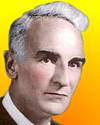
Died 21 Dec 1960 at age 77 (born 7 Feb 1883). quotes
Scottish-American mathematician and writer who contributed to analytic number theory (in which he found several inportant theorems), Diophantine analysis and numerical functions. In addition to about 250 papers on mathematical research, he also wrote for the layman in Men of Mathematics (1937) and Mathematics, Queen and Servant of Science (1951) among others. Under the name of John Taine, he also wrote science fiction.«
Scottish-American mathematician and writer who contributed to analytic number theory (in which he found several inportant theorems), Diophantine analysis and numerical functions. In addition to about 250 papers on mathematical research, he also wrote for the layman in Men of Mathematics (1937) and Mathematics, Queen and Servant of Science (1951) among others. Under the name of John Taine, he also wrote science fiction.«
The Search for E.T. Bell: Also Known as John Taine, by Constance Reid, William Watkins. - book suggestion.
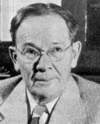
Died 21 Dec 1956 at age 79 (born 15 Jan 1877). quotes
Lewis M(adison) Terman was a U.S. psychologist who pioneered individual intelligence tests. During WW I, he was involved in mass testing of intelligence for the U.S. army. He expanded an English version of the French Binet-Simon intelligence test with which he introduced the IQ (Intelligence Quotient), being a ratio of chronological age to mental age times 100. (Thus an average child has an IQ of 100). He wrote about this metric in The Measurement of Intelligence (1916). He made a long-term study of gifted children (with IQ above 140) examining mental and physical aspect of their lives reported in the multi-volume Genetic Studies of Genius (1926-59).«
Lewis M(adison) Terman was a U.S. psychologist who pioneered individual intelligence tests. During WW I, he was involved in mass testing of intelligence for the U.S. army. He expanded an English version of the French Binet-Simon intelligence test with which he introduced the IQ (Intelligence Quotient), being a ratio of chronological age to mental age times 100. (Thus an average child has an IQ of 100). He wrote about this metric in The Measurement of Intelligence (1916). He made a long-term study of gifted children (with IQ above 140) examining mental and physical aspect of their lives reported in the multi-volume Genetic Studies of Genius (1926-59).«
Lewis M. Terman: Pioneer in Psychological Testing, by Henry L. Minton. - book suggestion.
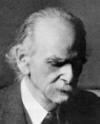
Age 70
Died 21 Dec 1942 at age 84 (born 9 Jul 1858). quotes
German-born American anthropologist who is best known for his work with the Kwakiutl Indians from Northern Vancouver, B.C., Canada. While studying the Kwakiutl, he established a culture-centred school of thought in anthropology that came to the forefront in the 20th century. He maintained that cultural traits - behaviors, beliefs, and symbols - were to be examined in their local context with historical, social and geographic conditions. The approach he established was continued by his students, which included Margaret Mead, Ruth Benedict, linguist Edward Sapir and Alfred L. Kroeber, who in turn influenced Claude Lévi-Strauss.«Date of death: DSB and NYT obituary gives 21 Dec 1942; EB gives 22 Dec 1942.
German-born American anthropologist who is best known for his work with the Kwakiutl Indians from Northern Vancouver, B.C., Canada. While studying the Kwakiutl, he established a culture-centred school of thought in anthropology that came to the forefront in the 20th century. He maintained that cultural traits - behaviors, beliefs, and symbols - were to be examined in their local context with historical, social and geographic conditions. The approach he established was continued by his students, which included Margaret Mead, Ruth Benedict, linguist Edward Sapir and Alfred L. Kroeber, who in turn influenced Claude Lévi-Strauss.«Date of death: DSB and NYT obituary gives 21 Dec 1942; EB gives 22 Dec 1942.
Anthropology and Modern Life, by Franz Boas. - book suggestion.
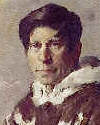
Died 21 Dec 1933 at age 54 (born 7 Jun 1879).
Danish-Eskimo explorer and ethnologist, who was an expert on the folklore and history of the Greenland Eskimos. In 1912, his first expedition covered 500 miles by dogsled (using more than fifty dogs) across Greenland's ice cap. On this, and seven more expeditions up to 1920, he studied and mapped the geography of northern Greenland, carried out scientific investigations of the ice cap. By spending a few weeks with various tribes, he studied the Eskimo cultures. Rasmussen investigated the theory that the Inuit and the North American Indians were both descended from migratory tribes from Asia, for his own travels showed that using only traditional Inuit technology it was possible to cover the entire distance using only one dog team.«
Danish-Eskimo explorer and ethnologist, who was an expert on the folklore and history of the Greenland Eskimos. In 1912, his first expedition covered 500 miles by dogsled (using more than fifty dogs) across Greenland's ice cap. On this, and seven more expeditions up to 1920, he studied and mapped the geography of northern Greenland, carried out scientific investigations of the ice cap. By spending a few weeks with various tribes, he studied the Eskimo cultures. Rasmussen investigated the theory that the Inuit and the North American Indians were both descended from migratory tribes from Asia, for his own travels showed that using only traditional Inuit technology it was possible to cover the entire distance using only one dog team.«
Across Arctic America: Narrative of the Fifth Thule Expedition, by Knud Rasmussen, et al. - book suggestion.
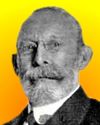
Died 21 Dec 1909 at age 67 (born 14 Jul 1842).
American chemical engineer who was an early supporter of standardisation and material testing in industry. From 1875, as a chemist for the Pennsylvania Railroad Company, he researched the metallurgy of steel rail tracks because their breakage was a serious hazard at that time. When he discovered enormous variation in the quality of steel and published his results (1878), the manufacturers were at first uncooperative. However, Dudley insisted on continuing testing, and rigorous standards for fuels, lubricants, paints, lighting devices and various mechanical parts of locomotives and rolling stock. He co-founded (1898) the American Society for Testing and Materials, and was its president from 1902 until his death.«
American chemical engineer who was an early supporter of standardisation and material testing in industry. From 1875, as a chemist for the Pennsylvania Railroad Company, he researched the metallurgy of steel rail tracks because their breakage was a serious hazard at that time. When he discovered enormous variation in the quality of steel and published his results (1878), the manufacturers were at first uncooperative. However, Dudley insisted on continuing testing, and rigorous standards for fuels, lubricants, paints, lighting devices and various mechanical parts of locomotives and rolling stock. He co-founded (1898) the American Society for Testing and Materials, and was its president from 1902 until his death.«
Died 21 Dec 1835 at age 81 (born 10 May 1754). quotes
Sir John Sinclair of Ulbster, 1st Baronet was a Scottish politician and writer who was the first to use the word “statistics.” He wrote on finance and agriculture. From 1971, he gathered data using a 160-question survey sent to every Scottish parish minister. The information he collected on natural history, population and production, filled 21 volumes of his work, The Statistical Account of Scotland between 1791 and 1799.
Sir John Sinclair of Ulbster, 1st Baronet was a Scottish politician and writer who was the first to use the word “statistics.” He wrote on finance and agriculture. From 1971, he gathered data using a 160-question survey sent to every Scottish parish minister. The information he collected on natural history, population and production, filled 21 volumes of his work, The Statistical Account of Scotland between 1791 and 1799.
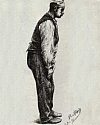
Died 21 Dec 1824 at age 69 (born 11 Apr 1755).
English physician and amateur paleontologist. He took over the practice of general medicine from his father. He wrote a little known monograph Observations on the Nature and Cure of Gout (1805). He was first to recognize a burst appendix as a cause of death, and wrote the first scientific article on appendicitis (1812). In his Essay on the Shaking Palsy (1817), he was the first to describe the neuromuscular disease which is now known by his name as Parkinson's disease, The symptoms of Parkinson's Disease are a generalized slowness of movement, a tremor or slight shaking on one side of the body when at rest, some stiffness of the limbs, and problems of gait or balance.«[Image: Shaking Palsy as illustrated in Parkinson's Essay on Shaking Palsy] more
English physician and amateur paleontologist. He took over the practice of general medicine from his father. He wrote a little known monograph Observations on the Nature and Cure of Gout (1805). He was first to recognize a burst appendix as a cause of death, and wrote the first scientific article on appendicitis (1812). In his Essay on the Shaking Palsy (1817), he was the first to describe the neuromuscular disease which is now known by his name as Parkinson's disease, The symptoms of Parkinson's Disease are a generalized slowness of movement, a tremor or slight shaking on one side of the body when at rest, some stiffness of the limbs, and problems of gait or balance.«[Image: Shaking Palsy as illustrated in Parkinson's Essay on Shaking Palsy] more
James Parkinson: His Life and Times, by A.D. Morris. - book suggestion.

In 2015, SpaceX both launched a rocket and, for this company’s first first time, gently landed the first stage at Cape Canaveral. After lifting the Falcon-9 rocket, the first stage booster was guided back to earth to make its first successful vertical landing. (Earlier trials had failed). It was designed to be reused. Although it costs $60 million to first build, it only costs $200,000 to refuel ready to relaunch. Elon Musk, CEO of Space X, thus demonstrated progress towards more competitive launch costs if this success could be routinely repeated. This more complex rocket was faster, and reached higher in space, than the smaller New Shepard rocket launched and landed the previous month (24 Nov 2015) by Jeff Bezos’ private space company Blue Origin.«
In 1999, a U.S. patent was granted for making a “Sealed Crustless Sandwich,” (No. 6,004,596), to David Geske and Len C. Kretchman of Menusaver, Inc. From 1995, they had successfully marketed their product to schools. Smucker bought the company and introduced “Uncrustables.” Shortly, Smucker alleged patent infringement by Abbie's Foods, Inc., a grocer and caterer, warning them to cease selling a crustless peanut butter and jelly sandwich. Albie's appealed to federal court (11 Jan 2001). Challenging the patent, Albie's requested (9 Mar 2001) a Patent Office re-examination. A patent requires non-obviousness, and is invalidated by any prior useage. Despite Smucker's further patent filings and appeals, the Patent Office finally cancelled the improvident patent (8 Dec 2006).«

In 1937, Snow White and the Seven Dwarfs, Walt Disney's first full-length (83 minutes), animated film opened in Los Angeles, California. Using the story adapted from Brothers Grimms' Fairy Tales, it was the first commercially successful film of its kind. This pioneering film made use of the multi-plane camera to achieve an effect of depth, introduced human characters modeled on live actors, and used larger painted cels. After two years and a then astronomical $1.5 million to create, it was released for its premiere during Christmas of 1937. Disney had to mortgage his house to pay for the film's production. This followed within a span of just 12 years since the first black and white talking Mickey Mouse in Steamboat Willie (1928).
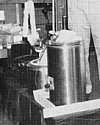
In 1933, dried human blood serum was prepared for the first time in the U.S. at the school of Medicine, University of Pennsylvania, Philadelphia, Pa. It was prepared by Drs. Earl W. Flosdorf, an experienced refrigeration engineer, and Stuart Mudd who created a glass apparatus to freeze-dry serum, the clear fluid in the blood that contains the proteins and antibodies formed by the body's immune system to protect against infection. The powdered, dried blood serum was used successfully for transfusions for the prevention of childhood diseases. The method was first described in April of the following year at a meeting of the American Chemical Society at St. Petersburg, Florida. Dried blood serum was used during WW II.[Image: detail from a photograph taken at an exhibit of the equipment. Shell-freezing unit far left, vacuum pump next to it, and next to it refrigeration trap to remove moisture from drying plasma. Metal cylinder in foreground serves as a drying chamber.]
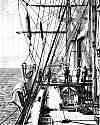
HMS Challenger, Instrument and Sampling Platform
In 1872, HMS Challenger sailed from Portsmouth, England, on the first expedition organized and funded for a specific scientific purpose. It was to examine the deep-sea floor and investigate specific questions about the oceam environment. In 1870, At the urging of Wyville Thomson, Professor of Natural History at Edinburgh University, the Royal Society requested the British Government to provide a ship for global ocean exploration. The British naval corvette HMS Challenger was a steam-assisted three-masted square-rigged wooden sailing vessel, converted from its original combat ship mission by removing cannon and fitting it with laboratories, dredging equipment and storage space. The expedition returned to Spithead on 24 May 1876, Fifty volume of reports were written.«
The Silent Landscape: The Scientific Voyage of HMS Challenger, by Richard Corfield. - book suggestion.
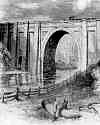
In 1829, first stone arch railroad bridge in US was dedicated at Baltimore. The Carrollton Viaduct crosses a wooded stretch of Gwynn's Falls. The viaduct was named for Charles Carroll of Carrollton, signer of the Declaration of Independence, who laid the first stone of the Baltimore & Ohio Railroad on 4 Jul 1828. Construction took over 9 months. Some 1,500 tons of granite were supported on huge wooden frameworks. until the keystones were in place and the massive 80 ft arch over the stream became self-supporting. Overall, the bridge is about 62-ft tall, and 300-ft long. On New Year's Day, 1830, it became America's first railroad destination, using a horse until the locomotive "Tom Thumb" came later in 1830. Trains have used it ever since.
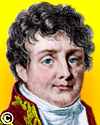
Fourier
In 1807, Fourier's memoir On the Propagation of Heat in Solid Bodies, was read to the Paris Institute, an important mathematical work, containing what we now call Fourier series, which he had worked upon since around 1804. A committee consisting of Lagrange, Laplace, Monge and Lacroix was set up to report on the work. Although now highly regarded, at the time, this memoir caused controversy. Lagrange and Laplace objected to Fourier's expansions of functions as trigonometrical series (the Fourier series). It was not until 1822 that his prize winning essay Théorie analytique de la chaleur was published by the Académie des Sciences. Jean Delambre, Secretary to the mathematical section, had arranged for the printing before he died.
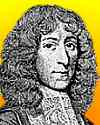
In 1641, John Mayow, an English chemist and physiologist, was baptized. His birth date is uncertain. Mayow is known for his studies of the relationships of atmospheric composition, combustion, and respiration. He noted both combustion and respiration use up only a small proportion of the available air. This he called spiritus nitro-aerous, which supported life and combustion (sometimes considered as discovery of oxygen.) The remainder of the air, he showed, does not support life, extinguishes a lighted candle and is insoluble in water. Mayow suggested that respiration is the source of animal heat, and that the foetus breathes through the placenta. He described the muscular actions around the chest cavity that are involved in respiration.




